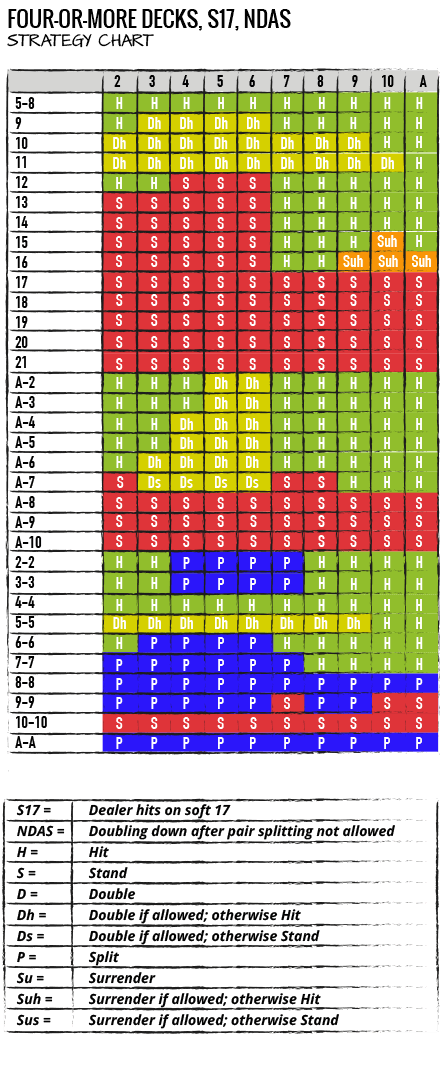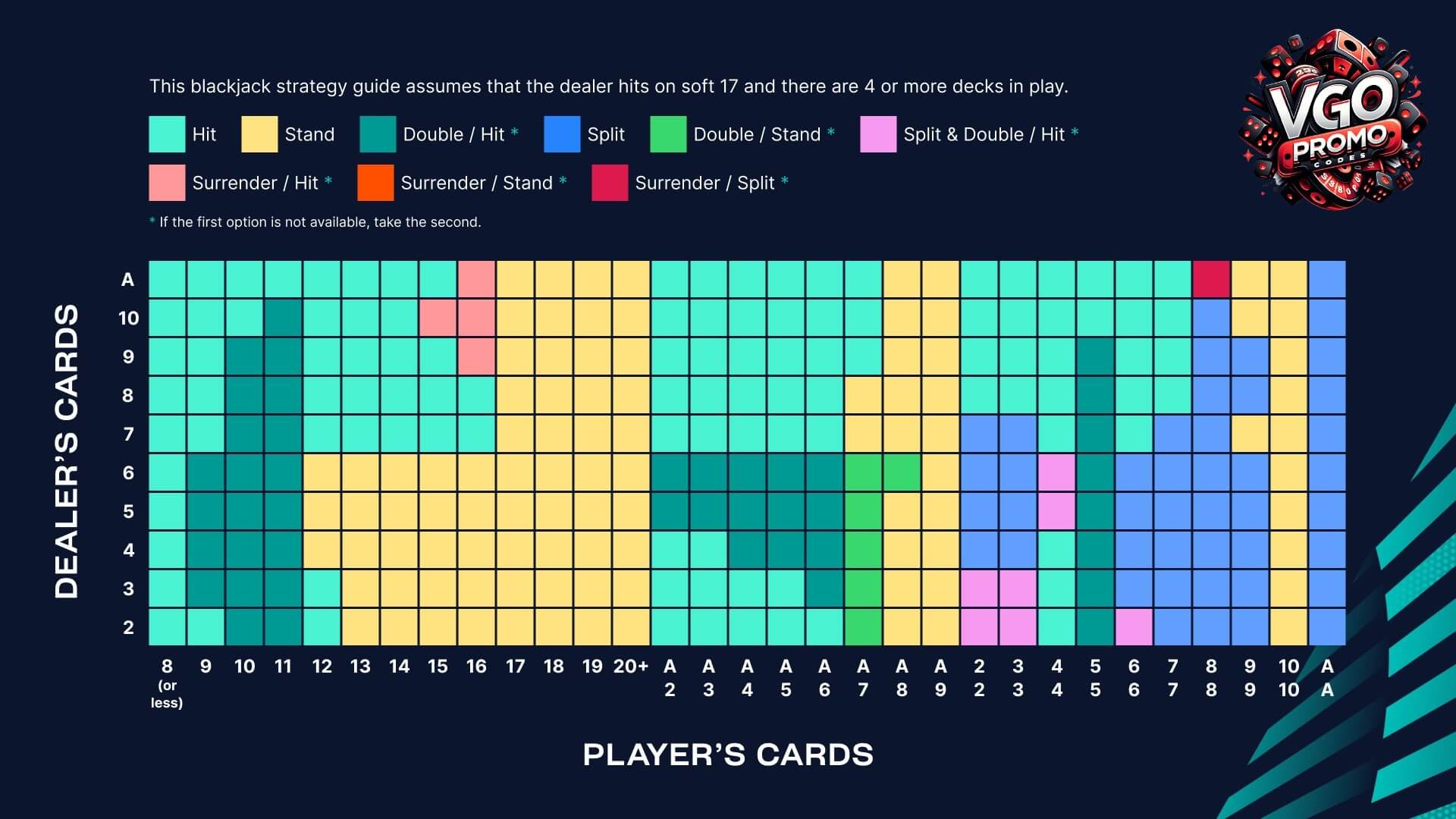An effective strategy for blackjack revolves around understanding basic strategy, which is a mathematically optimal way to play each hand.
Key Takeaways:
- Learn Basic Strategy: Basic strategy involves the best action (hit, stand, double down, split, or surrender) based on your hand’s total and the dealer’s upcard. Charts are available that lay out these actions.
- Always Stand on Hard 17 and Above: When your cards total 17 or more and don’t include an Ace counted as 11 (a “hard” hand), it’s generally best to stand.
- Hit or Double Down on 11 or Less: If your total is 11 or less, you cannot bust by taking another card. Consider doubling down if the dealer’s card is weak (like 3-6).
- Split Aces and Eights: Always split aces and eights. This increases your chances of hitting 21 or getting two strong hands.
- Never Split Tens or Face Cards: A hand of 20 is very strong, so splitting tens or face cards is not recommended.
- Consider the Dealer’s Upcard: Your decisions in blackjack should partly depend on what the dealer is showing. For example, if the dealer shows a 6 or lower, they are more likely to bust, so you might play more conservatively.
- Use Surrender Wisely: If available, surrender can be a valuable option when you have a weak hand and the dealer shows a strong card (like 9, 10, or Ace).
- Avoid Insurance Bets: Insurance typically offers poor odds and should generally be avoided unless you’re counting cards, which is a more advanced strategy.
- Manage Your Bankroll: Set a budget for your session and stick to it. Don’t chase losses, and don’t bet more than you can afford to lose.
- Practice and Experience: Experience is key in blackjack. Consider playing online, where you can try different strategies without the pressure of a live casino environment.
Let’s dive in shall we ?
Learn Basic Strategy
Basic strategy involves the best action (hit, stand, double down, split, or surrender) based on your hand’s total and the dealer’s upcard.
Charts are available that lay out these actions.

Here’s a bit more detail on how to use the basic strategy:
- Basic Strategy Charts: These charts are the easiest way to learn basic strategy. They show the best action (hit, stand, double down, split, or surrender) based on your hand’s total and the dealer’s upcard. The chart is typically organized with the player’s hand along the vertical axis and the dealer’s upcard along the horizontal axis.
- Interpreting the Chart:
- Your Hand’s Total: This is usually listed on the left side of the chart. It can be a hard total (without an Ace), a soft total (with an Ace counting as 11), or a pair.
- Dealer’s Upcard: This is shown across the top. You’ll compare this card with your hand to determine your move.
- Actions Explained:
- Hit (H): Take another card.
- Stand (S): Keep your current hand as is.
- Double Down (D): Double your bet, take one more card, and then stand.
- Split (SP): If you have a pair, you can split it into two separate hands and play each hand individually.
- Surrender (SU): If allowed, you can give up half your bet and end the hand immediately.
- Using the Chart:
- Find your hand on the vertical axis.
- Look at the dealer’s upcard along the top row.
- The intersection of your row and the dealer’s column suggests the optimal action.
- Memorizing the Chart: While having the chart handy is great, ideally, you should memorize the basic strategy. This can take some time, but it’s worth it for frequent players.
- Adapting to Rule Variations: Be aware that some casinos have rule variations. Adjust your strategy accordingly. For example, if the dealer hits on soft 17, this affects certain decisions in the chart.
Remember, while basic strategy can significantly reduce the house edge, it does not eliminate it. Blackjack is a game of probability, not certainty.
Always Stand on Hard 17 and Above
When your cards total 17 or more and don’t include an Ace counted as 11 (a “hard” hand), it’s generally best to stand.
In blackjack, standing on a hard 17 and above is a fundamental part of basic strategy.
Here’s why it’s advisable:
- Risk of Busting: When you have a hard 17 or higher, the risk of busting (going over 21) if you take another card is very high. For instance, any card above 4 will cause you to bust if you hit on a hard 17.
- Dealer’s Constraints: The dealer typically must hit until they reach a certain total (usually 17). When you stand on a hard 17 or higher, you’re essentially waiting to see if the dealer busts or ends up with a lower total.
- Statistical Outcomes: Mathematically, it’s been proven that standing on a hard 17 and above maximizes your chances of winning or at least not losing more than necessary.
- Assessing the Dealer’s Upcard: While you should always stand on a hard 17 or higher, it’s also important to consider the dealer’s upcard. For example, if the dealer has a weak upcard (like 4, 5, or 6), there’s a higher chance they will bust, making standing an even stronger play.
- Game Variations: Be aware of game rules variations. In some blackjack games, the dealer may hit on a soft 17 (a hand containing an Ace counted as 11), which slightly affects the player’s odds.
- Avoiding Over-Playing the Hand: One common mistake players make is over-playing their hand. Standing on a hard 17 or above is a disciplined move that respects the odds.
Remember, successful blackjack playing is about making the best decision based on statistical probabilities, not gut feelings or hunches.
Hit or Double Down on 11 or Less
If your total is 11 or less, you cannot bust by taking another card. Consider doubling down if the dealer’s card is weak (like 3-6).
In blackjack, hitting or doubling down when your total is 11 or less is a strategic move, and here’s why:
- No Risk of Busting: With a total of 11 or less, you can’t bust on the next card. This makes hitting a safe play since no single card will take you over 21.
- Opportunity to Improve Your Hand: Hitting gives you a chance to improve your hand. The goal is to get as close to 21 as possible without going over, and when you’re at 11 or under, you have a good opportunity to increase your total significantly.
- Doubling Down: This is a particularly strategic move when your total is 10 or 11 because you have a good chance of getting a 20 or 21 with one more card. Doubling down means you double your initial bet in exchange for one additional card, after which you must stand.
- Considering the Dealer’s Upcard: The decision to hit or double down should also factor in the dealer’s upcard. If the dealer shows a weak card (typically 3 through 6), they have a higher chance of busting, which makes doubling down more attractive. The weaker the dealer’s card, the more aggressive you can be with your doubling strategy.
- Rules and Limitations: Keep in mind that some casinos may have restrictions on when you can double down. Always be aware of the house rules in the game you are playing.
- Balancing Risk and Reward: While you can’t bust with 11 or less, consider the potential reward of hitting or doubling down against the risk. For example, if you have a total of 9 and the dealer shows a strong card, you might opt to hit rather than double down.
Using these strategies effectively requires a balance of understanding the odds, analyzing the dealer’s card, and being aware of the game’s specific rules.
Split Aces and Eights
Always split aces and eights. This increases your chances of hitting 21 or getting two strong hands.
Splitting Aces and Eights in blackjack is indeed a widely recommended strategy, and here’s why:
- Splitting Aces:
- Maximizing the Potential for 21: Each Ace gives you a good chance of hitting 21 with your next card. By splitting them, you double your chances.
- Avoiding a Weak Total: A single hand starting with two Aces is only a soft 12, which is a weak hand. Splitting them gives you a better shot at strong hands.
- Special Rules for Aces: In most casinos, after you split Aces, you’re typically allowed only one additional card on each Ace. Even with this limitation, the potential for a strong hand makes it worth splitting.
- Splitting Eights:
- Turning a Weak Hand into Two Stronger Ones: A hand of 16 (two eights) is weak and has a high risk of busting. By splitting, you can turn one poor hand into two potentially winning hands.
- Opportunity to Improve Both Hands: Each eight has a chance to be improved into a hand of 18, which is a much stronger position.
- Strategic Considerations:
- Against the Dealer’s Upcard: The decision to split should consider the dealer’s upcard. However, with Aces and Eights, the rule to split holds firm in almost all situations.
- Doubling After Splitting: Some casinos allow players to double down on the two new hands created after a split, which can be particularly beneficial with Eights.
- Bankroll Management: Ensure you have enough chips to cover the additional bet. Splitting doubles your bet since you must place an additional wager for the second hand.
- Game Rules Variations: Always be aware of specific table rules that might affect splitting, such as resplitting, doubling after a split, and how many cards you can draw to split Aces.
Splitting Aces and Eights is one of the most fundamental strategies in blackjack and can significantly affect the game’s outcome.
Never Split Tens or Face Cards
A hand of 20 is very strong, so splitting tens or face cards is not recommended.
In blackjack, the recommendation to never split tens or face cards is a key strategic principle.
Here’s the rationale behind this advice:
- Strength of a 20: A total of 20 is a very strong hand in blackjack. The only hand that beats it is 21. By splitting tens or face cards, you’re risking a winning hand for a chance at two potentially weaker hands.
- Risk of Weakening a Strong Position: When you split tens or face cards, you need to draw an Ace or a ten-value card on both split hands to be in as strong a position as you were with a 20. The odds of this happening are not high enough to justify the split.
- Dealer’s Position: Consider the dealer’s position. The dealer must hit on 16 and stand on all 17s. Your 20 is already in a very strong position against any dealer’s upcard. Splitting could turn a likely win into a potential loss or, at best, a less certain outcome.
- Economic Implications: When you split, you have to place an additional bet. Splitting tens or face cards can be financially disadvantageous, especially since your original hand was already strong.
- Game Psychology: Sometimes players are tempted to split tens or face cards out of a desire for more action or the hope of winning more. However, a disciplined approach focusing on the best mathematical play is more likely to be profitable in the long run.
In summary, while there are occasions in blackjack when splitting is the optimal strategy, tens and face cards are not among them. Holding onto a 20 is usually the best course of action.
Consider the Dealer’s Upcard
Your decisions in blackjack should partly depend on what the dealer is showing. For example, if the dealer shows a 6 or lower, they are more likely to bust, so you might play more conservatively.
Considering the dealer’s upcard is indeed a crucial aspect of blackjack strategy. Your decisions should be influenced by what the dealer is showing.
Here’s a breakdown of this approach:
- Dealer’s Upcard as a Guide:
- Weak Upcards (2-6): If the dealer shows a 2 through 6, they are more likely to bust. In this scenario, you might play more conservatively, especially if you have a borderline hand. For instance, if you have a total of 12-16, you might stand rather than risk busting yourself, hoping that the dealer will bust.
- Strong Upcards (7-Ace): When the dealer shows a 7 or higher, they have a better chance of making a strong hand. In this case, you’ll often need to be more aggressive in your strategy, hitting on stiffer hands (like 12-16) where you would stand if the dealer had a weaker upcard.
- Adjusting Your Strategy:
- Doubling Down: When the dealer has a weak upcard, you might be more inclined to double down on your strong hands (like 9, 10, or 11) because the dealer is more likely to bust.
- Splitting Pairs: The decision to split pairs can also be influenced by the dealer’s upcard. For instance, you might split 2s and 3s against a dealer’s 4-6 but not against a stronger upcard.
- Balancing Risk and Reward: The dealer’s upcard doesn’t guarantee the outcome, but it does help you assess the risk. Your decisions should balance the potential risk of busting your hand against the likelihood of the dealer busting or making a strong hand.
- Remembering Basic Strategy: While considering the dealer’s upcard, always align your decision with basic blackjack strategy, which already factors in the dealer’s visible card.
- House Rules Impact: Be aware of the casino’s specific rules, such as whether the dealer stands or hits on soft 17, as these can also influence your decisions based on the dealer’s upcard.
Using the dealer’s upcard as a guide is part of playing smart, strategic blackjack. For more comprehensive strategies and insights into blackjack and other casino games, resources like VGO Promo can be valuable. Always remember to gamble responsibly, and make decisions based on sound strategy rather than emotion.
Use Surrender Wisely
If available, surrender can be a valuable option when you have a weak hand and the dealer shows a strong card (like 9, 10, or Ace).
Using the surrender option wisely in blackjack can indeed be a strategic move under certain circumstances.
Here’s an overview of how and when to consider surrendering:
- Understanding Surrender: Surrender allows you to forfeit your hand in exchange for half of your bet back. This option is only available on your first two cards before you take any other action on the hand.
- When to Surrender:
- Hard 16 vs. Dealer’s 9, 10, or Ace: If you have a hard 16 (not a pair of 8s, which should be split) and the dealer shows a 9, 10, or an Ace, surrendering can be a good choice. The chances of improving your hand are low, and the dealer has a strong chance of having a higher total.
- Hard 15 vs. Dealer’s 10: Surrendering a hard 15 is advisable when the dealer shows a 10. The probability of the dealer achieving a strong hand is high, and your chances of busting or ending with a weak hand are also considerable.
- Benefits of Surrender:
- Minimizing Losses: When the odds are heavily against you, surrendering can minimize your losses. Losing half your bet is often better than the expected loss if you played the hand to completion.
- Strategic Play: Knowing when to surrender is part of playing smart blackjack. It’s about making decisions that reduce the house edge over the long term.
- Not Always Available: It’s important to note that not all blackjack games offer the surrender option. Additionally, there are two types of surrender – early and late – which are available under different conditions and have different rules.
- Use Surrender Sparingly: While surrender can be a strategic tool, it should be used sparingly. Overusing surrender can lead to unnecessary losses. It’s most effective when used in situations with the highest statistical disadvantage.
- Incorporating into Basic Strategy: Surrender should be considered as part of your overall blackjack strategy. It’s one of the options, like hitting, standing, doubling down, or splitting, and should be used judiciously.
Using surrender wisely is a way to improve your blackjack play by making informed decisions based on your hand and the dealer’s upcard.
Avoid Insurance Bets
Insurance typically offers poor odds and should generally be avoided unless you’re counting cards, which is a more advanced strategy.
Avoiding insurance bets in blackjack is generally advised for most players, and here’s why:
- What is an Insurance Bet?: Insurance is a side bet offered when the dealer’s upcard is an Ace. You’re essentially betting that the dealer’s hole card (the face-down card) is a 10, giving them a blackjack. The insurance bet usually costs half of your original wager and pays 2:1.
- Poor Odds: The odds of the dealer having a 10-value card to complete a blackjack are less than one-third. Statistically, you’re more likely to lose the insurance bet than win it.
- Separate from the Main Game: It’s important to remember that the insurance bet is entirely separate from the main game. It’s a bet on the dealer’s hand, not on yours.
- House Edge: The house edge on insurance bets is generally higher than the main game. If you’re not counting cards, taking insurance is usually a losing proposition in the long run.
- Card Counting Consideration: Professional or advanced players who count cards may opt for insurance in specific situations. Card counting can provide insight into the likelihood of the dealer having a 10-value card. However, for most players, card counting is not a practical strategy.
- Strategic Play: A more strategic approach is to stick with the basic blackjack strategy, which advises against taking insurance. This strategy considers the odds and long-term outcomes.
- Managing Bankroll: Consistently taking insurance can quickly deplete your bankroll. The side bet may seem like a safe option, but it usually works in favor of the casino.
In summary, while the insurance bet in blackjack might seem like a prudent measure against the dealer’s potential blackjack, it typically does not offer favorable odds for the player. Therefore, it’s advisable to avoid it unless you are skilled in card counting.
Manage Your Bankroll
Set a budget for your session and stick to it. Don’t chase losses, and don’t bet more than you can afford to lose.
Managing your bankroll effectively is a crucial aspect of responsible gambling, especially in games like blackjack.
Here are key principles to consider:
- Set a Budget: Before starting your gambling session, decide how much money you’re willing to spend. This amount should be what you can afford to lose without impacting your daily life.
- Stick to Your Budget: Discipline is key. Once you’ve set your budget, stick to it. It’s easy to get caught up in the excitement of the game, but exceeding your budget can lead to problems.
- Avoid Chasing Losses: One of the most common mistakes in gambling is trying to chase losses. If you’re having a bad run, it’s better to accept the loss and not bet more in an attempt to recover your funds. This often leads to even bigger losses.
- Betting Strategy: Decide on your betting strategy ahead of time. This might include setting bet sizes relative to your bankroll. For instance, betting no more than 1-5% of your bankroll on a single hand can be a sensible approach.
- Keep Track of Spending: Regularly monitor how much you are spending and winning. This helps you stay aware of your financial status and make informed decisions.
- Know When to Stop: Gambling should be entertaining, not a means to make money. If you find that you’re no longer enjoying the game, or if it’s causing stress, it’s time to stop.
- Use Tools and Resources: Many casinos and online gaming platforms offer tools to help you manage your bankroll, such as setting deposit limits or self-exclusion options.
- Be Aware of the Gambler’s Fallacy: Don’t fall for the gambler’s fallacy—the belief that past events affect future outcomes in games of chance. Each hand in blackjack is independent of the last.
- Take Breaks: Regular breaks can help you make better decisions and keep your gambling habits in check.
- Seek Help if Needed: If you feel you’re having difficulty managing your gambling habits, don’t hesitate to seek help from professionals.
Bankroll management is not just about limiting losses, it’s also about maximizing enjoyment and playing responsibly.
Practice and Experience
Experience is key in blackjack. Consider playing online, where you can try different strategies without the pressure of a live casino environment.
Absolutely, practice and experience are crucial for improving your skills and confidence in blackjack.
Here’s how to effectively gain experience:
- Online Blackjack Platforms: Online blackjack is a great tool for practice. It allows you to play at your own pace, try out different strategies, and get comfortable with the game without the pressure of a live casino environment.
- Free Play or Demo Games: Many online platforms offer free play or demo versions of blackjack. These games use play money, so you can practice without risking real money. This is an excellent way to get familiar with the game’s rules and try out basic strategy.
- Low-Stakes Tables: When you’re ready to play with real money, start at low-stakes tables. This allows you to experience the thrill of real gambling without risking large sums of money.
- Implementing Strategy: Use your practice sessions to implement and refine your blackjack strategies, such as basic strategy, bankroll management, and understanding when to hit, stand, double down, split, or surrender.
- Learning from Mistakes: As with any skill, learning from your mistakes is vital. Pay attention to which moves work well and which don’t, and adjust your strategy accordingly.
- Keeping Track of Progress: Keep notes or a log of your sessions. This can help you track your progress, understand your playing patterns, and identify areas for improvement.
- Understanding Variations: There are various blackjack games with different rules. Use your practice time to understand these variations and how they affect your strategy.
- Balance Between Practice and Theory: While practical experience is essential, also spend time reading about strategies, watching tutorials, or even using blackjack simulators and trainers.
- Setting Realistic Goals: Set achievable goals for your learning and playing. This could be understanding certain strategies, reaching a particular skill level, or simply gaining more confidence in the game.
- Responsible Gambling: Always practice responsible gambling habits, even in an online environment. Set limits on your time and money when playing.
Remember, the key to becoming better at blackjack is a combination of theoretical knowledge and practical experience.
FAQ
The most successful blackjack strategy is the basic strategy, a set of guidelines that tells you the best way to play every hand you’re dealt. This strategy is based on mathematical probability and takes into account your hand’s value and the dealer’s upcard. Adherence to the basic strategy can significantly reduce the house edge.
The optimum strategy in blackjack involves following the basic strategy combined with sound bankroll management and sensible decision-making. Advanced techniques like card counting can further refine this strategy, but these require significant practice and are not suitable for most players.
The best way to win at blackjack is to learn and consistently apply the basic strategy, avoid side bets like insurance, manage your bankroll carefully, and never chase your losses. Also, choosing games with player-friendly rules, such as 3:2 payouts for blackjack, can increase your chances of winning.
The “2 1 strategy” in blackjack is not a commonly recognized term. It might be a misunderstanding or a miscommunication. In blackjack, strategies are typically referred to as “basic strategy,” “progressive betting,” “card counting,” and such. If you’re referring to betting systems, a common one is the “1-2-3-5” system, which is a type of progressive betting strategy.





